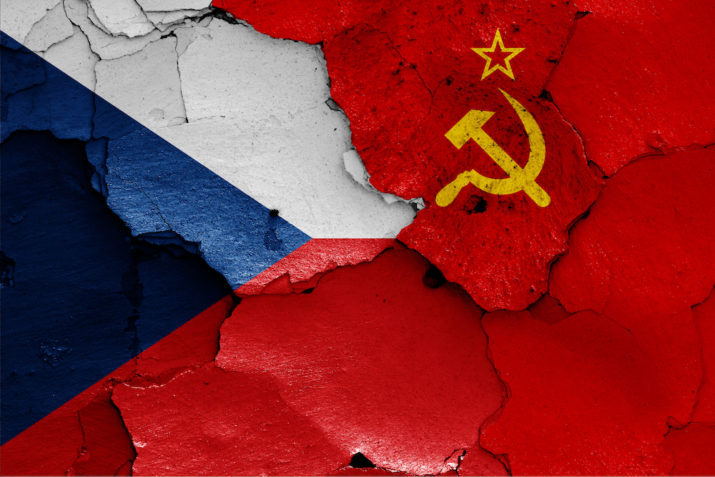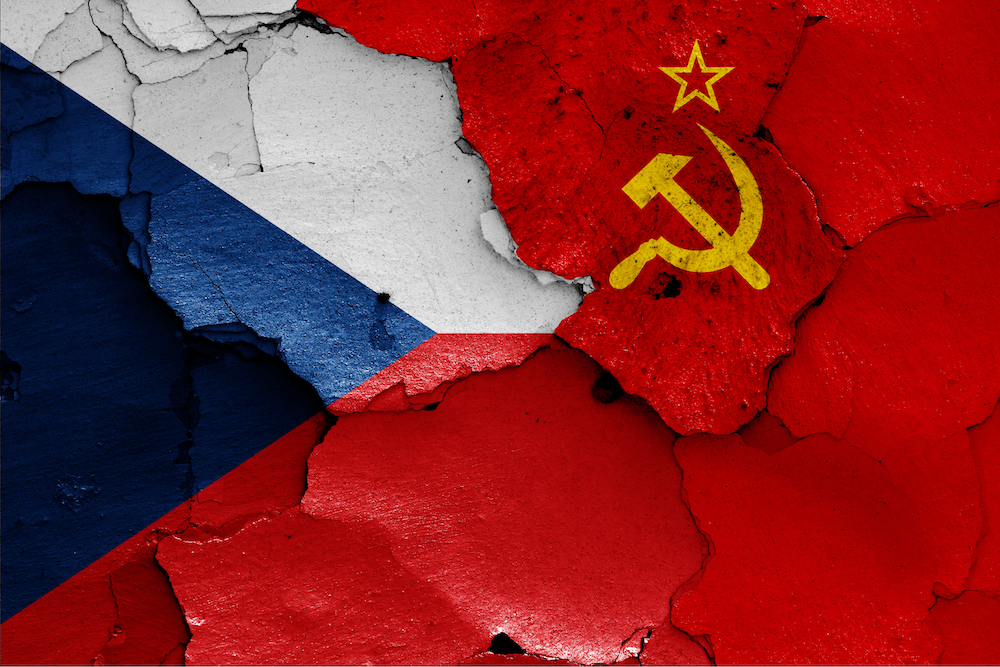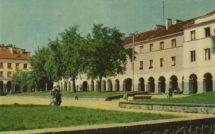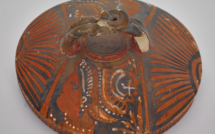

This is part of our special feature, Digitization of Memory and Heritage in Eastern Europe.
You might come across something similar online: mixed Mixed clips from Leonid Brezhnev’s New Year’s addresses of 1970 and 1977 and parts of the text re-sung by popular youtuber Enjoykin. Adolf Hitler’s figure in Der Untergang (2004) shouting at army generals, yet, according to the subtitles, his anger was caused by this year’s high-school entrance math exams in the Czech Republic. Leaked army footage from the Yugoslav War is shown with slowed-down music from the 1980s with purple filter added. Undated film footages from peaceful streets of Warsaw—in fact stemming from the WWII period—accompanied with nostalgic comments of viewers: “I wish I could have lived then!” What do all these digital appearances have in common?
Massive amounts of audiovisual heritage are available online. Public archives offer curated content on their websites, while private companies such as British pathé use video sharing portals to circulate their extensive audiovisual holdings. Casual collectors make amateur footage as well as uncurated professional content accessible on their websites or social-network profiles. Once online, users watch, share and comment, but also appropriate or download videos for remix and recirculation. These are perfect examples of what has been coined as produsage (Bruns 2008)[1] or developed from the earlier prosumption (Toffler 1980).[2] Both terms seek to express the omnipresent hybridity of a passive usage or consumption of digital material on the one hand, and its (re-)production on the other, which is specific for the contemporary digital environment. The once complementary, yet clearly divided roles of a producer and a consumer are now overlapping, blended, and the division line between them is blurred. Control over content is hard to achieve, if at all—not only for copyright owners.
The whole phenomenon is far from being “under control” for social scientists as well. Even when reducing the issue to archives and other history-related footage, we miss an analytical understanding of what kind of material is actually attractive enough to circulate and how to find out. On what platforms and in what context does the re-use happen? Do these new forms of circulation challenge the established historical narratives? What are the implications for the understanding of archives, heritage and historical identity in general? These are only a few of the questions arising, yet they are lacking authoritative answers.
New Project on Popular Re-Use of Audiovisual Archives
The European History Reloaded (CADEAH) project is one of the first attempts to research into the contemporary online circulation and appropriation of audiovisual material relating to the past. It is mostly archival material, but there are also popular historical films and other similar footage in broader European context. It was inspired by the JPICH Digital Heritage call financed within the European Union’s Horizon 2020 program, which tried to encourage critical analysis of current trends in the online culture that would result in curatorial assistance.
The international consortium of CADEAH stretches between digital humanities, media studies, digital anthropology, and historiography. The developers within the digital-humanities team at Humlab, University of Umeå, Sweden, led by Pelle Snickars, try to find out in what ways video fingerprinting techniques represent a suitable tool for empirical tracing of such re-use. The project will result in a manual and possibly a software tool for the owners of content to track and trace re-used videos. There is ongoing research on how such solutions can be repurposed for research in heritage studies and the digital humanities. The cooperation further involves the Netherlands, where there is a digital-ethnography team at the Centre for Media Research at Utrecht University, which is coordinated by Eggo Müller. This part of the consortium seeks to find out who the people manipulating the material are, what their motivation and strategy are, what kind of groups or communities they form and what reactions their engagement evokes. And finally, there is a team of historians at the Institute of Contemporary History, Czech Academy of Sciences in Prague, led by the author of this text. Their study focuses on how established narratives of European past are shaped through such appropriation, what new perspectives on European history and identity they create, and what this has to do with the curation of audiovisual archives: Should curators prevent, or encourage the re-use of their material? Yet, there are even more general questions involved that address the status and the actual expertise of historiography and archival science. Are they becoming even more of a “collaborative practice” as Raphael Samuel once suggested in his Theatres of Memory? (Samuel 1994)[3]
The cooperation within the consortium, which involves also associate partners among leading European agencies in cultural heritage curation and history education, such as Europeana, EUscreen, and Euroclio, has already brought some important, yet mostly unexpected concept-related findings. The first one relates to the contradiction between the European scope of research and its predominantly national objects: the individual national, or regional environments are actually producing very diverse examples of the studied phenomenon; within the context of contemporary decentralized popular history, it is thus proving to be very difficult to actually identify any shared narratives of the European past that would be considered by the respective national communities as relevant to them and appropriated or manipulated frequently. It appears that it is the way of approaching the past, strongly shaped by accessible technology, rather than the actual objects of manipulation or narratives included in them, that is commonly shared by the respective communities,. The relevant historical themes seem to be too diverse—and too driven by the historical experience of the community—to speak about a European narrative being modified. This will be further demonstrated in the following chapter of this article.
Second, the use of heritage as an analytical or even a descriptive concept has created an issue. In spite of being both a part of the EU call and of the full project title, not all partners in the consortium find it useful or even feasible to the same extent. In some European languages, it fully overlaps with “inheritance” and refers purely to the architectural monuments, landscapes, and other items formally enrolled in the UNESCO World Heritage lists. It is necessary to see “heritage” as a mental construct that attributes significance to certain places, artefacts, or forms of behavior from the past, yet at the same time, to perceive the processes of doing so as essentially political, be it the lobbying for including an item in an official heritage list, or the current international policy of encouraging ordinary people in heritage definition and creation. Heritage conservation, digital heritage including, is not merely a technical or managerial matter, but a cultural practice, a form of cultural politics (Logan/Nic Crath/Kockel 2016).[4] We therefore suggest that heritage is understood as a specific regime of historicity (Hartog 2003, 2016)[5] following the earlier modes in which societies related to the past through antiquities, monuments and museums (Eriksen 2014).[6] Instead of building on the heritage concept, the CADEAH initial research has tended to use the more academically established concept of (collective) memory of past events, exploring its transformations in the digital era and the potential of digital media and technology to act as memory actors or mediators.
Communism Scanned and Reloaded
In the following overview, we shall exemplify the interaction between historical memory and digital technologies, using the case of the Communist dictatorship in Czechoslovakia (1948-1989) and its public memorizing in the Czech Republic in the past two decades.
Rather than being motivated by a desire for development of digital humanities, the Czech relationship between history/historiography and the digital technology was initiated in the context of long discussions about opening access to the archives produced by the former Communist secret service—the State Security. The digital technology turned out to be understood not only as a tool helping to get to know more about the past, but as an instrument for a deeper process of “coming to terms with the Communist past.” In the early 2000s, it was believed that a citizen studying (online and via remote access) the digitized files produced by the State Security actively exposes the real face of Communist dictatorship. Yet, one has to imagine the colossal archives we are talking about: 280 million pages of text, packed with personal data and very difficult to decode, contextualize and interpret even for experts in the field. Obviously, only a tiny part has until now been transformed into computer files. This “digital utopia” as Czech historian Vítězslav Sommer coined it was based on the expectation that the new technology would become a key factor in shaping the position of Czech society to its Communist past. In that sense, this idea could be ranked among all the completions of the “unfinished revolutions” of 1989, as James Mark labelled the memory boom after 2000 (Mark 2010).[7]
Practically speaking, the Communist police archives were opened by law of 2004. As of 2007, the Open Past project was initiated by the Ministry of the Interior. A new archive department of the Ministry was supposed to start the files’ digitization and to arrange an online access. Consequently, in 2008, the Institute for the Study of Totalitarian Regimes, a completely new institution funded from the state budget and depending on parliamentary oversight, was established and the previous Archive of Security Services was made its part. It was this highly politicized Institute that managed the digitization of StB files after that point. In practice, the digitization meant scanning documents, without creating the proper metadata or without any systematic approach to selecting what to scan. Under the direction of Pavel Žáček, formerly a radical anti-Communist student leader, the Institute was deliberately choosing the files for digitization in order to target leading public figures and the most notorious cases of police abuse. Later, the consequent reshuffles of Institute directors perfectly followed the will of respective political parties in power.
Once again, it was the digitization of State Security files that became one of the key elements in debates concerning the Institute: professional archivists criticized the destruction of documents, missing metadata etc., while the other side suggested that whoever tries to burden the digitization, prevents the past from being known and “uncovered.” Conspiracy theories concerning the enemies of digitization became a crucial part of the dispute over the secret service files, which in reality had much more general, ethical, and historical implications: Who had created the documents and why? How reliable were they? What parts had actually been left for us after vast destruction of files during the 1989 revolution? And how about the sensitive personal data included?
The fact that the Institute engages in higher-quality digitization these days, does not affect the central implication of the case, namely that a seemingly neutral technology turned into a political act and was discussed and evaluated as such. This confirms an urgent need for pursuing a political history of the digital technology as was recently suggested in debates concerning the methods of digital humanities and their supposed value neutrality.[8]
What difference does it make if we shift away from a state-sponsored digitization of a highly specific corpus of archives toward the current popular appropriation and online re-use of audiovisual material coming from the Communist era, or dealing with its aftermath? Our preliminary collection, a few examples from which opened this article, seems to divide into three different types of approaches to remediation.
First, there are large amounts of more-or-less amateur compilations of professional footage published elsewhere, put together and annotated in order to offer an alternative or inverse interpretation of events. To give an example, the Great Velvet Lie viral video[9] suggests a conspiracy behind the 1989 Velvet Revolution in Czechoslovakia: Václav Havel and all his dissident companions had always liked money and in spite of their extensive partying knew what to do in 1989 when striving for even more money and power. Similar re-appropriations still use the traditional documentary genre and forms, they keep some traces of where their footage comes from, such as logos of TV channels, and they refer to certain generally accepted interpretations of events and challenge them.
The second type of popular re-mediations mixes a famous footage with a different sound, subtitles, or changes a part of the video track. The fascinating remake of a scene from one episode of Thirty Cases of Major Zeman, a major Socialist-era TV action series, will make a good example.[10] While in the original the Communist detectives watch the documentation of acts by a brutal murderer, in the remix their disgusted comments, like “I’ve never seen anything like that. He’s a real monster” or “Look at him. This is an experienced trickster,” aim at the current Czech Prime Minister. The intriguing thing is the new “charging” of the scene. The original production from the 1970s was made to promote a radical post-1968 (i.e. hard-line Communist) interpretation of major events of post-war Czechoslovak history, and was directly supervised by the Ministry of Interior and the Communist Party. According to the series, the Socialist collectivization of agriculture faced evil enemies that the policemen had to find; the dissidents were layabouts and drug addicts, and so on. As a result, there was a heated discussion in the 1990s about whether such Communist propaganda should be allowed to appear on TV again; yet after scandalizing the public Czech TV broadcaster for running it, several private channels benefited from its popularity among Czech viewers.[11] What is more important, however, is that within the remix, the detectives have become neutral, the context of the series has turned comical, and it is today’s Prime Minister, rather than Communist propaganda that is the object of parody, which is a major revision not only of the original narrative from the 1970s, but also of the radical anti-Communist perspective of the 1990s.
The third approach seems to be more international. It employs more sophisticated digital technology, but results in an entirely different mode of narrating history. The following example could be illustrative: Inspired by the vaporwave music subculture, which is an electronic music microgenre that arranges the 1980s and 1990s music with visual images into a specific aesthetic style, a subgroup called laborwave was formed that seems to be openly nostalgic about (at least a visual image of) Communism.[12] The music component stays the same, while the visual part consists of Socialist-era footages, either urban Socialist landscapes with scarce cars and people, Party rallies or even military operations with the characteristic pastel-colored filters added. Nobody seems to miss text or a more accurate description of the source, period, and place, not to speak of the context. The style is the message. It is extremely difficult to analyze such material with our academically and culturally established expectations of authors endowed with rationality, a political view, and social background. Its utmost ambivalence makes it into something completely resisting any methodical interpretation. Historical images, including war scenes, are aestheticized, mixed with temporarily unrelated elements, and put out. The old divisions between ethnic groups, Communists and non-Communists, transition winners, and losers are forgotten, or rather, not needed at all.
Most authors dealing with such multiple, globally reachable and shared images of the past have abandoned the original digital optimism that expected both historical memory and knowledge to benefit from the technology-bound democratization. Nowadays, they even advocate that this is the end of collective memory as such, because that was inherently mobilizing, legitimizing the “us” and demonizing others. Most of today’s memorizing does not do that. It offers unregulated emergence of past images instead. As Andrew Hoskins put it in his recent reappraisal of digital memory, there is huge potential for the digitized, present and past, “to emerge, awaiting (re)discovery, (re)connection and (re)mediation, in unprescribed and unpredictable future times.” (Hoskins 2018)[13] This can lead to very intense, shared, though short-lived remembering together, as Roger I. Simon coined the fact that complete strangers can share their supposed experiences online, renegotiate their relations to historical events and identify with those memorialized without having any real-life relation to them. (Simon 2012)[14] When posting a photo of a prefab house similar to where your family used to live on Facebook, it takes seconds to invoke an emotionally powerful representation and make other people remember it together with you. Yet, it is the awareness of the complexities of the past that is at stake.
Adéla Gjuričová is a senior researcher at the Institute of Contemporary History of the Czech Academy of Sciences in Prague. She focuses on politics and society during the late Socialist era, the 1989 revolutions, and post-Communist transformations in Central Europe. Currently, she leads the Czech team within the JPICH CADEAH project on “European History Reloaded: Curation and Appropriation of Digital Audiovisual Heritage.”
She is co-author of Rozděleni minulostí: Vytváření politických identit v České republice po roce 1989 [Divided by the Past: Political Identities in the Czech Republic after 1989] (Prague, Václav Havel Library 2011), Lebenswelten von Abgeordneten in Europa 1860-1990 [The Life-Worlds of Members of Parliament, 1860-1990] (Düsseldorf, KGParl – Droste 2014) and Návrat parlamentu: Češi a Slováci ve Federálním shromáždění 1989-1992 [The Return of Parliament: The Czechs and Slovaks in the Federal Assembly 1989-1992] (Prague, Argo – ÚSD AV ČR 2018).
References
[1] Bruns, Axel (2008): Blogs, Wikipedia, Second Life, and Beyond : From Production to Produsage. New York.
[2] Toffler, Alvin (1980): The Third Wave. New York.
[3] Samuel, Raphael (1994): Theatres of Memory: Past and Present in Contemporary Culture. London.
[4] Logan, William – Nic Craith, Máiréad – Kockel, Ullrich (2016): A Companion to Heritage Studies. Chichester.
[5] Hartog, François (2003): Régimes d’historicité. Présentisme et expériences du temps. Paris. In English: Hartog, François (2016): Regimes of Historicity: Presentism and Experiences of Time. New York.
[6] Eriksen, Anne (2014): From Antiquities to Heritage: Transformations of Cultural Memory. New York – Oxford.
[7] Mark, James (2010): The Unfinished Revolution. Making Sense of the Communist Past in Central-Eastern Europe. New Haven-London.
[8] E.g. Allington, Daniel – Brouillette, Sarah – Golumbia, David: Neoliberal Tools (and Archives): A Political History of Digital Humanities. In: Los Angeles Review of Books, May 1, 2016. Cf. subsequent debate in LARB.
[9] V. Havel: sametová lež. https://www.youtube.com/watch?v=iCOFp_Jt1S8
[10] Major Zeman vers Babiš. https://www.youtube.com/watch?v=Zih3WkmcxHk
[11] Zápotocký, Jan (2013): Seriál Třicet případů majora Zemana po roce 1989: jeho revitalizace, reflexe a deideologizace [Thirty Cases of Major Zeman after 1989: The Series‘ Revitalization, Reflection and De-Ideologization]. MA Thesis, FSV UK, Prague.
[12] E.g. “E a s t G e r m a n L A B O R W A V E 1 9 4 9 — 1 9 9 0“. https://www.youtube.com/watch?v=dun7Ra1sLJM
[13] Hoskins, Andrew (2018): Digital media and the precarity of memory. www.researchgate.net, p. 7.
[14] Simon, Roger I. (2012): Remembering together: social media and the formation of the historical present. In: Giaccardi, Elisa (ed.): Heritage and Social Media. Understanding heritage in a participatory culture. Oxon – NY, pp. 89-106.
Photo: Flags of Czech republic and Soviet Union | Shutterstock
Published on September 10, 2019.




